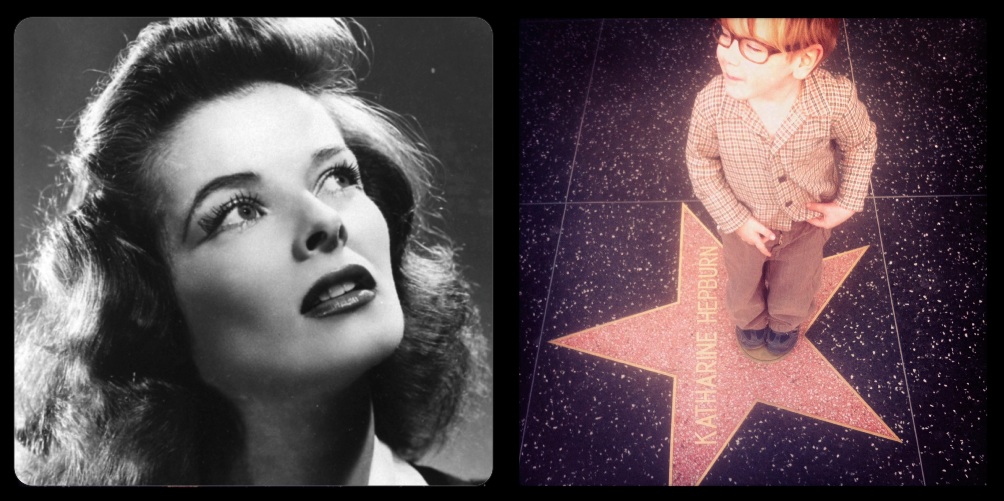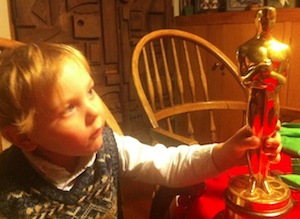 A weekly feature in which my four-year-old son is let loose on the Hollywood Walk of Fame, one of the most popular tourist attractions in Los Angeles, and chooses a star from among the more than 2,500 honorees. His “random” picks sometimes reveal unexplained connections such as the summer day in 2012 when he sat down on the star of actress Celeste Holm and refused to budge. We later learned that the Oscar-winning actress had died only hours earlier.
A weekly feature in which my four-year-old son is let loose on the Hollywood Walk of Fame, one of the most popular tourist attractions in Los Angeles, and chooses a star from among the more than 2,500 honorees. His “random” picks sometimes reveal unexplained connections such as the summer day in 2012 when he sat down on the star of actress Celeste Holm and refused to budge. We later learned that the Oscar-winning actress had died only hours earlier.
After stepping over her star on the 6200 block of Hollywood Boulevard week after week, Charlie finally decided to honor one of my favorite actresses in movie history. He must have waited on purpose — Katharine Hepburn is the perfect choice for the weekend before the Oscars since no other actor in history has won more awards (four, all for Best Actress, plus a 2005 win for Cate Blanchett for playing Katharine Hepburn in The Aviator!). Hepburn also used to hold the record for acting nominations as well but her 12 nominations have long been eclipsed by Meryl Streep’s 18. Hepburn does retain another record, however — the longest span between her first and last Academy Award wins — a whopping 48 years between her Oscars for Morning Glory (1933) and On Golden Pond (1981). In order for Meryl Streep to beat that, she’ll have to take home a statue in 2031. We’ll be watching, Meryl!
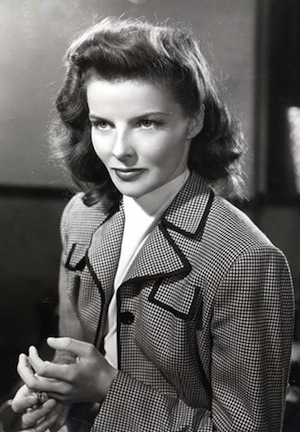 Born on May 12, 1907, Hepburn was always someone who marched to the beat of her own drum. Considering how little patience she had for the studio system and the publicity machine movie stars were subject to, it’s amazing how quickly she found success when she moved from New York to Hollywood at the age of 25. Scouted by Hollywood agent Leland Hayward when she was appearing on Broadway, Hepburn’s first film was a starring role A Bill of Divorcement opposite John Barrymore. Not bad, especially since many movie executives saw her as too unusual and off-putting for stardom. Her first director, George Cukor, with whom she would make many of her most beloved movies, was impressed from the moment he met her. “There was this odd creature,” he said, “she was unlike anyone I’d ever heard.” Despite her early Oscar, Hepburn starred in a series of commercial flops in the 1930s that caused some exhibitors to label her “box office poison,” a ludicrous charge that she was able to turn around thanks to her talent, shrewdness, and tenacity.
Born on May 12, 1907, Hepburn was always someone who marched to the beat of her own drum. Considering how little patience she had for the studio system and the publicity machine movie stars were subject to, it’s amazing how quickly she found success when she moved from New York to Hollywood at the age of 25. Scouted by Hollywood agent Leland Hayward when she was appearing on Broadway, Hepburn’s first film was a starring role A Bill of Divorcement opposite John Barrymore. Not bad, especially since many movie executives saw her as too unusual and off-putting for stardom. Her first director, George Cukor, with whom she would make many of her most beloved movies, was impressed from the moment he met her. “There was this odd creature,” he said, “she was unlike anyone I’d ever heard.” Despite her early Oscar, Hepburn starred in a series of commercial flops in the 1930s that caused some exhibitors to label her “box office poison,” a ludicrous charge that she was able to turn around thanks to her talent, shrewdness, and tenacity.
There are many books written about Hepburn’s life and career, including a few she wrote herself, so to mark Charlie’s excellent choice, I think I’ll just mention my ten favorite Katharine Hepburn performances. If you’re not familiar with her particular brand of genius, the films listed below would be a great place to start. Of course, ask me to name my favorite Katharine Hepburn films tomorrow and I may list ten other performances!
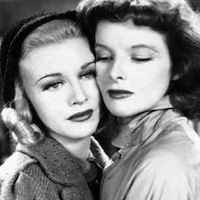 Stage Door (1937). Hepburn’s Terry Randall in this sparkling Gregory La Cava film may be the character that most closely mirrored her own beginnings as an actress. In Stage Door, based on the play by Edna Ferber and George S. Kaufman, Hepburn plays a privileged society girl who decides to give acting a try and moves in with a bunch of struggling actresses at a New York boarding house for thespians. Her scenes with co-stars Ginger Rogers, Adolph Menjou, Eve Arden, Andrea Leeds, Gail Patrick, Lucille Ball and Ann Miller are perfect from beginning to end, and the movie includes the catchphrase that is a favorite among Katharine Hepburn imitators the world over: “The calla lilies are in bloom again, such a strange flower, suitable to any occasion…”
Stage Door (1937). Hepburn’s Terry Randall in this sparkling Gregory La Cava film may be the character that most closely mirrored her own beginnings as an actress. In Stage Door, based on the play by Edna Ferber and George S. Kaufman, Hepburn plays a privileged society girl who decides to give acting a try and moves in with a bunch of struggling actresses at a New York boarding house for thespians. Her scenes with co-stars Ginger Rogers, Adolph Menjou, Eve Arden, Andrea Leeds, Gail Patrick, Lucille Ball and Ann Miller are perfect from beginning to end, and the movie includes the catchphrase that is a favorite among Katharine Hepburn imitators the world over: “The calla lilies are in bloom again, such a strange flower, suitable to any occasion…”
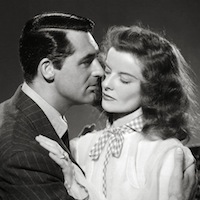 The Philadelphia Story (1940). In one of my favorite films of all time, Hepburn plays Tracy Lord, wealthy Philadelphia socialite, just before her wedding to husband #2, George Kittredge (John Howard). But who should show up the day before the Big Event? None other than husband #1, C.K. Dexter Haven (Cary Grant), who brings with him Spy magazine reporter Macauley Connor (James Stewart) and photographer Liz Imbrie (Ruth Hussey), masquerading as friends of Tracy’s off-screen brother. Tracy sees through the ruse but must play along to avoid a scandal involving her father (John Halliday) while her flighty mother (Mary Nash) and smart-as-a-whip younger sister, Dinah (Virginia Weidler), welcome Dexter with open arms. If you haven’t seen this brilliant film, directed by George Cukor and based on the play by Philip Barry, you are in for a treat. Hepburn was savvy enough to buy this property when she was starring in it on Broadway and sell it to MGM on the condition that she must play the lead. The gamble worked and her days as “box office poison” were over.
The Philadelphia Story (1940). In one of my favorite films of all time, Hepburn plays Tracy Lord, wealthy Philadelphia socialite, just before her wedding to husband #2, George Kittredge (John Howard). But who should show up the day before the Big Event? None other than husband #1, C.K. Dexter Haven (Cary Grant), who brings with him Spy magazine reporter Macauley Connor (James Stewart) and photographer Liz Imbrie (Ruth Hussey), masquerading as friends of Tracy’s off-screen brother. Tracy sees through the ruse but must play along to avoid a scandal involving her father (John Halliday) while her flighty mother (Mary Nash) and smart-as-a-whip younger sister, Dinah (Virginia Weidler), welcome Dexter with open arms. If you haven’t seen this brilliant film, directed by George Cukor and based on the play by Philip Barry, you are in for a treat. Hepburn was savvy enough to buy this property when she was starring in it on Broadway and sell it to MGM on the condition that she must play the lead. The gamble worked and her days as “box office poison” were over.
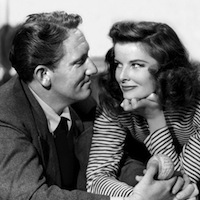 Woman of the Year (1942). Directed by George Stevens with a screenplay by Ring Lardner, Jr. and Michael Kanin, this was Hepburn’s first of nine pairings with Spencer Tracy, with whom she would be romantically linked until his death in 1967. Here the two play colleagues at the New York Chronicle. Hepburn’s Tess Harding is a highly educated political affairs columnist while Tracy’s Sam Craig is the paper’s top sports reporter. A feud between the two journalists leads to a budding romance and then marriage. But can they find true happiness when they come from such different worlds? The film was adapted into a 1981 Broadway musical starring Hepburn’s friend Lauren Bacall.
Woman of the Year (1942). Directed by George Stevens with a screenplay by Ring Lardner, Jr. and Michael Kanin, this was Hepburn’s first of nine pairings with Spencer Tracy, with whom she would be romantically linked until his death in 1967. Here the two play colleagues at the New York Chronicle. Hepburn’s Tess Harding is a highly educated political affairs columnist while Tracy’s Sam Craig is the paper’s top sports reporter. A feud between the two journalists leads to a budding romance and then marriage. But can they find true happiness when they come from such different worlds? The film was adapted into a 1981 Broadway musical starring Hepburn’s friend Lauren Bacall.
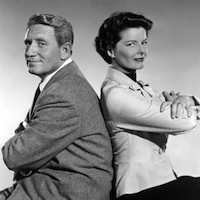 Adam’s Rib (1949). Another “battle of the sexes” between Hepburn and Tracy, again directed by George Cukor, with a wonderful script by Ruth Gordon and Garson Kanin. In this film, Hepburn and Tracy are married lawyers who end up on opposite sides of a case involving a woman (the great Judy Holliday in her first big movie role) accused of attempting to murder her philandering husband (Tom Ewell). This was the sixth pairing of the popular on-screen couple, and while their films were definitely products of their time, it’s refreshing to see how, for the most part, Hepburn’s strong characters were never expected to drop their careers or to try to appear less intelligent than their mates.
Adam’s Rib (1949). Another “battle of the sexes” between Hepburn and Tracy, again directed by George Cukor, with a wonderful script by Ruth Gordon and Garson Kanin. In this film, Hepburn and Tracy are married lawyers who end up on opposite sides of a case involving a woman (the great Judy Holliday in her first big movie role) accused of attempting to murder her philandering husband (Tom Ewell). This was the sixth pairing of the popular on-screen couple, and while their films were definitely products of their time, it’s refreshing to see how, for the most part, Hepburn’s strong characters were never expected to drop their careers or to try to appear less intelligent than their mates.
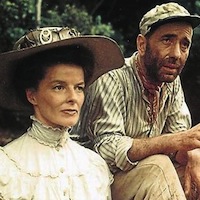 The African Queen (1951). While many of Hepburn’s male contemporaries would play leading romantic roles well into their fifties and beyond, Katharine Hepburn, now in her forties, was already at the age in Hollywood where actresses often started playing middle-aged spinsters. But if you’re going to play a repressed spinster, be sure to do it in a spectacular film like John Huston’s The African Queen. Set in Africa during World War I, Humphrey Bogart plays Charlie Allnut, a booze-swilling riverboat owner while Hepburn is Rose Sayer, a straight-laced missionary who convinces Bogart to use his boat to attack a German ship. Much of the film was shot on location in the Congo and Uganda. The film won Bogart his only Best Actor Oscar. Hepburn later published a funny memoir about the experience called The Making of The African Queen, or How I Went to Africa with Bogart, Bacall, and Huston and Almost Lost My Mind.
The African Queen (1951). While many of Hepburn’s male contemporaries would play leading romantic roles well into their fifties and beyond, Katharine Hepburn, now in her forties, was already at the age in Hollywood where actresses often started playing middle-aged spinsters. But if you’re going to play a repressed spinster, be sure to do it in a spectacular film like John Huston’s The African Queen. Set in Africa during World War I, Humphrey Bogart plays Charlie Allnut, a booze-swilling riverboat owner while Hepburn is Rose Sayer, a straight-laced missionary who convinces Bogart to use his boat to attack a German ship. Much of the film was shot on location in the Congo and Uganda. The film won Bogart his only Best Actor Oscar. Hepburn later published a funny memoir about the experience called The Making of The African Queen, or How I Went to Africa with Bogart, Bacall, and Huston and Almost Lost My Mind.
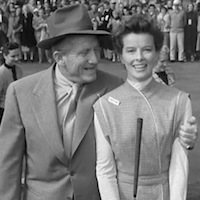 Pat and Mike (1952). Katharine Hepburn and Spencer Tracy, director George Cukor, and writers Ruth Gordon and Garson Kanin teamed up yet again for this fun romp about a brilliant athlete (Hepburn) and a crotchety sports promoter (Tracy) who, while they drive each other nuts at first, eventually find true love. The Kanins took full advantage of their friend Katharine Hepburn’s natural athleticism in this script — an avid golfer, tennis player, and swimmer, Hepburn actually performed all of the sports footage seen in the movie. The film also featured Aldo Ray, William Ching, Jim Backus, and a young Charles Bronson.
Pat and Mike (1952). Katharine Hepburn and Spencer Tracy, director George Cukor, and writers Ruth Gordon and Garson Kanin teamed up yet again for this fun romp about a brilliant athlete (Hepburn) and a crotchety sports promoter (Tracy) who, while they drive each other nuts at first, eventually find true love. The Kanins took full advantage of their friend Katharine Hepburn’s natural athleticism in this script — an avid golfer, tennis player, and swimmer, Hepburn actually performed all of the sports footage seen in the movie. The film also featured Aldo Ray, William Ching, Jim Backus, and a young Charles Bronson.
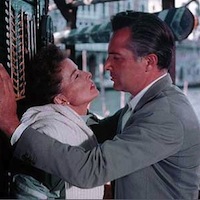 Summertime (1955). 48-year-old Hepburn plays another lonely spinster in this moving David Lean film that was one of the director’s favorites. Traveling in Italy for the summer, Hepburn’s Jane Hudson, a secretary at an elementary school back home, becomes depressed watching all the happy couples in Venice. But when she meets a mysterious Italian who shows great interest in her, she finds herself seriously pondering a life-changing relationship. This was a different kind of role for Hepburn, but one she performed with skill and great poignancy. Filmed on location in Venice, Hepburn performed a stunt in which she had to back up too far and fall into one of the famous canals. Unfortunately, the eye infection that resulted plagued her for the rest of her life.
Summertime (1955). 48-year-old Hepburn plays another lonely spinster in this moving David Lean film that was one of the director’s favorites. Traveling in Italy for the summer, Hepburn’s Jane Hudson, a secretary at an elementary school back home, becomes depressed watching all the happy couples in Venice. But when she meets a mysterious Italian who shows great interest in her, she finds herself seriously pondering a life-changing relationship. This was a different kind of role for Hepburn, but one she performed with skill and great poignancy. Filmed on location in Venice, Hepburn performed a stunt in which she had to back up too far and fall into one of the famous canals. Unfortunately, the eye infection that resulted plagued her for the rest of her life.
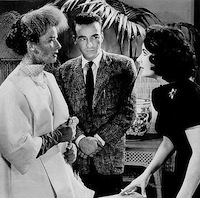 Suddenly, Last Summer (1959). Gore Vidal wrote the screenplay for this film based on Tennessee Williams’ play. Though hamstrung by the censors, Vidal’s script still gave Katharine Hepburn and Elizabeth Taylor the opportunity to give riveting performances in this Joseph Mankiewicz film set in 1930s New Orleans. Taylor plays a young woman named Catherine who is institutionalized after witnessing the death of her cousin Sebastian during a summer holiday abroad. Hepburn plays Sebastian’s wealthy mother, Violet Venable, who tries to convince a young surgeon at the facility (Montgomery Clift) to give her niece a lobotomy to erase the girl’s sordid memories of Sebastian’s final days and death. The production was plagued with problems including Clift’s dependency on drugs and alcohol after a near-fatal car crash. Both Vidal and Tennessee Williams were unhappy with the final film but I still think it’s worth seeing for both Hepburn’s and Taylor’s powerful performances.
Suddenly, Last Summer (1959). Gore Vidal wrote the screenplay for this film based on Tennessee Williams’ play. Though hamstrung by the censors, Vidal’s script still gave Katharine Hepburn and Elizabeth Taylor the opportunity to give riveting performances in this Joseph Mankiewicz film set in 1930s New Orleans. Taylor plays a young woman named Catherine who is institutionalized after witnessing the death of her cousin Sebastian during a summer holiday abroad. Hepburn plays Sebastian’s wealthy mother, Violet Venable, who tries to convince a young surgeon at the facility (Montgomery Clift) to give her niece a lobotomy to erase the girl’s sordid memories of Sebastian’s final days and death. The production was plagued with problems including Clift’s dependency on drugs and alcohol after a near-fatal car crash. Both Vidal and Tennessee Williams were unhappy with the final film but I still think it’s worth seeing for both Hepburn’s and Taylor’s powerful performances.
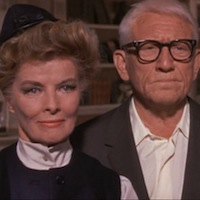 Guess Who’s Coming to Dinner (1967). The ninth and final on-screen pairing of Katherine Hepburn and Spencer Tracy is one of their best. While this Stanley Kramer film might seem a bit dated today, it broke ground as one of the first films to present a positive view of interracial relationships and marriage, something that was still illegal in many states. Tracy and Hepburn play Matt and Christina Drayton, a wealthy, liberal couple living in an upper-class neighborhood in San Francisco. Their long-held beliefs are tested when their daughter (played by Katharine Houghton, Hepburn’s real-life niece) returns home from a Hawaiian vacation with an African American man (Sidney Poitier) whom she plans to marry. Hepburn eventually gets behind the match, but will Tracy follow suit? Tracy was very ill during the filming but delivers a magnificent performance. He died just two weeks after filming was completed.
Guess Who’s Coming to Dinner (1967). The ninth and final on-screen pairing of Katherine Hepburn and Spencer Tracy is one of their best. While this Stanley Kramer film might seem a bit dated today, it broke ground as one of the first films to present a positive view of interracial relationships and marriage, something that was still illegal in many states. Tracy and Hepburn play Matt and Christina Drayton, a wealthy, liberal couple living in an upper-class neighborhood in San Francisco. Their long-held beliefs are tested when their daughter (played by Katharine Houghton, Hepburn’s real-life niece) returns home from a Hawaiian vacation with an African American man (Sidney Poitier) whom she plans to marry. Hepburn eventually gets behind the match, but will Tracy follow suit? Tracy was very ill during the filming but delivers a magnificent performance. He died just two weeks after filming was completed.
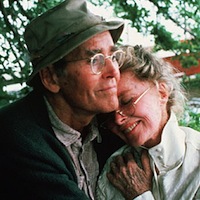 On Golden Pond (1981). Hepburn won her final Best Actress Oscar for this film directed by Mark Rydell, with a screenplay by Ernest Thompson (based on his own play), and co-starring real-life father and daughter Henry and Jane Fonda. Hepburn and Fonda play Ethel and Norman Thayer. When their daughter Chelsea (Jane Fonda) visits them at their summer cottage, the longtime tensions that have existed between father and daughter become quite apparent. Jane Fonda bought the film rights to Thompson’s play specifically for the chance to work with her dad, with whom she shared some of the relationship issues that their characters experience. Though they had both been huge movie stars for decades, Hepburn had never worked with Henry Fonda either, and she admired him so much that she gave him Spencer Tracy’s favorite hat which Fonda wore throughout the film. The two actors had a wonderful chemistry, and Hepburn was delighted that the film finally brought Henry Fonda a long-overdue Best Actor Oscar, shortly before his 1982 death.
On Golden Pond (1981). Hepburn won her final Best Actress Oscar for this film directed by Mark Rydell, with a screenplay by Ernest Thompson (based on his own play), and co-starring real-life father and daughter Henry and Jane Fonda. Hepburn and Fonda play Ethel and Norman Thayer. When their daughter Chelsea (Jane Fonda) visits them at their summer cottage, the longtime tensions that have existed between father and daughter become quite apparent. Jane Fonda bought the film rights to Thompson’s play specifically for the chance to work with her dad, with whom she shared some of the relationship issues that their characters experience. Though they had both been huge movie stars for decades, Hepburn had never worked with Henry Fonda either, and she admired him so much that she gave him Spencer Tracy’s favorite hat which Fonda wore throughout the film. The two actors had a wonderful chemistry, and Hepburn was delighted that the film finally brought Henry Fonda a long-overdue Best Actor Oscar, shortly before his 1982 death.
But wait — how can that be the end of my list? Am I INSANE? What about Little Women, Bringing Up Baby, Holiday, Desk Set, Long Day’s Journey Into Night, The Lion in Winter, Rooster Cogburn and so many more? You really can’t go wrong watching a Katharine Hepburn film — even when the Bryn Mawr-educated actress is playing a Chinese peasant in 1944’s Dragon Seed! Following On Golden Pond, Hepburn made just two more films (along with several TV movies) before she died on June 29, 2003, at the age of 96. She lived life her way until the very end. Before Charlie steps off her star, let’s take a look at the original trailer from one of Katharine Hepburn’s best:

